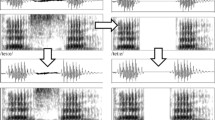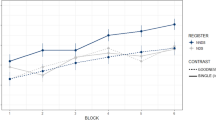Abstract
An ongoing debate in the speech production literature suggests that the initial building block to build up speech sounds differs between languages. That is, Germanic languages are suggested to use the phoneme, but Japanese and Chinese are proposed to use the mora or syllable, respectively. Several studies investigated this matter from a chronometric perspective (i.e., RTs and accuracy). However, a less attention has been paid to the actual acoustic utterances. The current study investigated the verbal responses of two Japanese–English bilingual groups of different proficiency levels (i.e., high and low) when naming English words and found that the presence or absence of vowel epenthesis depended on proficiency. The results indicate that: (1) English word pronunciation by low-proficient Japanese English bilinguals is likely based on their L1 (Japanese) building block and (2) that future studies would benefit from analyzing the acoustic data as well when making inferences from chronometric data.


Similar content being viewed by others
References
Baayen, R. H. (2008). Analyzing linguistic data: A practical introduction to statistics using R. Cambridge: Cambridge University Press.
Barr, D. J., Levy, R., Scheepers, C., & Tily, H. J. (2013). Random effects structure for confirmatory hypothesis testing: Keep it maximal. Journal of Memory and Language, 68(3), 255–278.
Beckman, M. (1982). Segment duration and the ‘mora’ in Japanese. Phonetica, 39(2–3), 113–135.
Boersma, P., & Weenink, D. (2016). PRAAT: doing phonetics by computer [Computer program]. Version 6.0.23. Retrieved December 12, 2016 from http://www.praat.org/
Brysbaert, M., & New, B. (2009). Moving beyond Kučera and Francis: A critical evaluation of current word frequency norms and the introduction of a new and improved word frequency measure for American English. Behavior Research Methods, 41(4), 977–990.
Carr, P., & Montreuil, J. P. (2013). Phonology (2nd edn.). London: Palgrave MacMillan.
Caramazza, A. (1997). How many levels of processing are there in lexical access? Cognitive Neuropsychology, 14(1), 177–208.
Chen, J.-Y., Chen, T.-M., & Dell, G. S. (2002). Wordform encoding in Mandarin Chinese as assessed by the implicit priming task. Journal of Memory and Language, 46, 751–781.
Davidson, L., & Stone, M. (2003). Epenthesis versus gestural mistiming in consonant cluster production: an ultrasound study. In Proc. of the West Coast Conference on Formal Linguistics (Vol. 22, pp. 165–178).
Dell, G. S. (1986). A speading activation theory of retrieval in language production. Psychological Review, 93, 226–234.
Dehaene-Lambertz, G., Dupoux, E., & Gout, A. (2000). Electrophysiological correlates of phonological processing: A cross-linguistic study. Journal of Cognitive Neuroscience, 12(4), 635–647.
Dupoux, E., Kakehi, K., Hirose, Y., Pallier, C., & Mehler, J. (1999). Epenthetic vowels in Japanese: A perceptual illusion? Journal of Experimental Psychology: Human Perception and Performance, 25(6), 1568.
Fleischhacker, H. (2005). Similarity in phonology: Evidence from reduplication and loan adaptation. UCLA Ph.D. dissertation.
Fujimoto, M. (2015). Vowel devoicing. The handbook of Japanese language and linguistics: Phonetics and phonology. Berlin: Mouton de Gruyter.
Gouskova, M. (2002). Falling sonority, loanwords, and Syllable Contact. Papers from the 37th Meeting of the Chicago Linguistic Society, 1, 175–186.
Ida, K., Nakayama, M., & Lupker, S. J. (2015). The functional phonological unit of Japanese–English bilinguals is language dependent: Evidence from masked onset and mora priming effects. Japanese Psychological Research, 57, 38–49.
Ito, J., & Mester, A. (1995). Japanese phonology. In J. Goldsmith (Ed.), The Handbook of Phonological Theory (pp. 817–838). Oxford: Blackwell.
Jaeger, T. F. (2008). Categorical data analysis: Away from ANOVAs (transformation or not) and towards logit mixed models. Journal of Memory and Language, 59(4), 434–446.
Janda, L. A., Nesset, T., & Baayen, R. H. (2010). Capturing correlational structure in Russian paradigms: a case study in logistic mixed-effects modeling. Corpus Linguistics and Linguistic Theory, 6(1), 29–48.
Kubozono, H. (1999). Nihongo no Onsei. Tokyo: Iwanami Shoten.
Kureta, Y., Fushimi, T., & Tatsumi, I. F. (2006). The functional unit of phonological encoding: Evidence for moraic representation in native Japanese speakers. Journal of Experimental Psychology: Learning, Memory, and Cognition, 32, 1102–1119.
Levelt, W. J., Roelofs, A., & Meyer, A. S. (1999). A theory of lexical access in speech production. Behavioral and Brain Sciences, 22(1), 1–38.
Li, C., Wang, M., & Davis, J. (2017). The phonological preparation unit in spoken word production in a second language. Bilingualism: Language and Cognition, 20, 351–366. https://doi.org/10.1017/S1366728915000711.
Masuda, H., & Arai, T. (2010). Processing of consonant clusters by Japanese native speakers: Influence of English learning backgrounds. Acoustical Science and Technology, 31, 320–327.
Meyer, A. S. (1990). The time course of phonological encoding in language production: The encoding of successive syllables of a word. Journal of Memory and Language, 29, 524–545.
Meyer, A. S. (1991). The time course of phonological encoding in language production: Phonological encoding inside a syllable. Journal of Memory and Language, 30, 69–89.
Nagara, S. (1972). JapanesePidgin English in Hawaii: a bilingual description. Honolulu: University of Hawaii Press.
Nakayama, M., Kinoshita, S., & Verdonschot, R. G. (2016). The emergence of a Phoneme-sized unit of speech planning in Japanese–English bilinguals. Frontiers in Psychology, 7, 175.
O’Seaghdha, P. G., Chen, J.-Y., & Chen, T.-M. (2010). Proximate units in word production: phonological encoding begins with syllables in Mandarin Chinese but with segments in English. Cognition, 115, 282–302. https://doi.org/10.1016/j.cognition.2010.01.001.
Roelofs, A. (2015). Modeling of phonological encoding in spoken word production: from germanic languages to mandarin Chinese and Japanese. Japanese Psychological Research, 57, 22–37. https://doi.org/10.1111/jpr.12050.
Verdonschot, R. G., Kiyama, S., Tamaoka, K., Kinoshita, S., La Heij, W., & Schiller, N. O. (2011). The functional unit of Japanese word naming: evidence from masked priming. Journal of Experimental Psychology: Learning, Memory and Cognition., 37, 1458–1473.
Verdonschot, R. G., Nakayama, M., Zhang, Q.-F., Tamaoka, K., & Schiller, N. O. (2013). The proximate phonological unit of Chinese–English bilinguals: proficiency matters. PLoS One, 8, e61454.
Funding
This study was funded by a Grant-In-Aid (C) from the Japan Society for the promotion of Science (No. 17K02748) to Rinus G. Verdonschot.
Author information
Authors and Affiliations
Corresponding author
Ethics declarations
Conflict of interest
Rinus G. Verdonschot declares that he has no conflict of interest. In addition, Hinako Masuda declares that she has no conflict of interest.
Research involving human and/or animal participants
All procedures performed in studies involving human participants were in accordance with the ethical standards of the institutional and/or national research committee and with the 1964 Helsinki declaration and its later amendments or comparable ethical standards.
Informed consent
Informed consent was obtained from all individual participants included in the study.
Appendices
Appendix 1
See Table 4.
Appendix 2
See Table 5.
Appendix 3
See Fig. 3.
Trellis plot depicting the log-odds ratios (see Baayen, 2008; Janda et al., 2010) for all 75 words divided by Bilingual Group (o onset, m medial, f final, HPB high-proficient bilingual, LPB low-proficient bilingual). A log-odds ratio lower than zero (i.e., the middle line) indicates an inclination to no-epenthesis, while a ratio higher than zero indicates an inclination to epenthesis. The zero line indicates equal inclination for both
Rights and permissions
About this article
Cite this article
Verdonschot, R.G., Masuda, H. Sumacku or Smack? The value of analyzing acoustic signals when investigating the fundamental phonological unit of language production. Psychological Research 84, 547–557 (2020). https://doi.org/10.1007/s00426-018-1073-9
Received:
Accepted:
Published:
Issue Date:
DOI: https://doi.org/10.1007/s00426-018-1073-9





